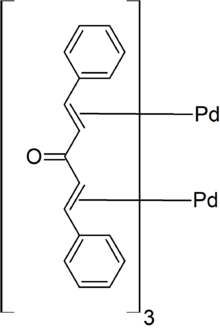This is an old revision of this page, as edited by CheMoBot (talk | contribs) at 07:06, 30 March 2011 (Updating {{chembox}} (no changed fields - added verified revid - updated 'UNII_Ref', 'ChemSpiderID_Ref', 'StdInChI_Ref', 'StdInChIKey_Ref', 'ChEMBL_Ref', 'KEGG_Ref') per Chem/Drugbox validation (). The present address (URL) is a permanent link to this revision, which may differ significantly from the current revision.
Revision as of 07:06, 30 March 2011 by CheMoBot (talk | contribs) (Updating {{chembox}} (no changed fields - added verified revid - updated 'UNII_Ref', 'ChemSpiderID_Ref', 'StdInChI_Ref', 'StdInChIKey_Ref', 'ChEMBL_Ref', 'KEGG_Ref') per Chem/Drugbox validation ()(diff) ← Previous revision | Latest revision (diff) | Newer revision → (diff) | |
 | |
| Names | |
|---|---|
| IUPAC name Tris(dibenzylideneacetone)dipalladium | |
| Other names Pd2(dba)3 | |
| Identifiers | |
| CAS Number | |
| ECHA InfoCard | 100.122.794 |
| Properties | |
| Chemical formula | C51H42O3Pd2 |
| Molar mass | 915.73 g·mol |
| Melting point | 152 -155 °C |
| Except where otherwise noted, data are given for materials in their standard state (at 25 °C , 100 kPa).
| |
Tris(dibenzylideneacetone)dipalladium(0) or Pd2(dba)3 is an organometallic complex based on palladium and dibenzylideneacetone used in organic chemistry. It was discovered in 1970.
Preparation and structure
It is prepared from dibenzylideneacetone and sodium tetrachloropalladate. The complex has a dark purple/brown color, and, because it is commonly recrystallized from chloroform, it is often supplied as the adduct Pd2(dba)3•CHCl3.
In Pd2(dba)3, the pair of Pd atoms are separated by 320 pm but are tied together by dba units. The Pd(0) centres are bound to the alkene parts of the dba ligands.
Applications
Pd2(dba)3 is used as a source of soluble Pd(0), particularly as a catalyst for various coupling reactions in which it undergoes oxidation to Pd(II). Examples of reactions using this reagent are the Negishi coupling, Suzuki coupling, Carroll rearrangement, Trost asymmetric allylic alkylation, as well as Buchwald–Hartwig amination. A related Pd(0) complex is tetrakis(triphenylphosphine)palladium(0).
References
- Takahashi, Y.; Ito, Ts.; Sakai, S.; Ishii, Y. (1970). "A novel palladium(0) complex; bis(dibenzylideneacetone)palladium(0)". Journal of the Chemical Society D: Chemical Communications: 1065. doi:10.1039/C29700001065.
- Encyclopedia of Reagents for Organic Synthesis, L.A. Paquette, Ed.: J. Wiley and Sons: Sussex, England, 1996
- Pierpont, Cortlandt G.; Mazza, Margaret C. (1974). "Crystal and molecular structure of tris(dibenzylideneacetone)dipalladium(0)". Inorg. Chem. 13: 1891. doi:10.1021/ic50138a020.
- Hartwig, J. F. (2010). Organotransition Metal Chemistry, from Bonding to Catalysis. New York: University Science Books. ISBN 189138953X.